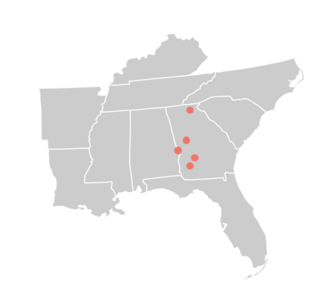
The International Union for Conservation of Nature (IUCN) Red List of Threatened Species, founded in 1964, is the world's most comprehensive inventory of the global conservation status of biological species. It uses a set of precise criteria to evaluate the extinction risk of thousands of species and subspecies. These criteria are relevant to all species and all regions of the world. With its strong scientific base, the IUCN Red List is recognized as the most authoritative guide to the status of biological diversity. A series of Regional Red Lists are produced by countries or organizations, which assess the risk of extinction to species within a political management unit.

The pink-billed lark is a species of lark in the family Alaudidae found in southern Africa. Its natural habitat is subtropical or tropical dry lowland grassland.

The buff-vented bulbul is a species of songbird in the bulbul family, Pycnonotidae. It is found in south-eastern Myanmar, south-western Thailand, on the Malay Peninsula, Sumatra and nearby islands. Its natural habitat is subtropical or tropical moist lowland forests. It is threatened by habitat loss.

The cryptic flycatcher is a species of bird in the family Muscicapidae. It is endemic to the Philippines only being found in the island of Mindanao. Its natural habitat is tropical moist mid-montane forests from 600 - 1,500 meters.

Medionidus penicillatus, the gulf moccasinshell, is a rare species of freshwater mussel in the family Unionidae, the river mussels. This aquatic bivalve mollusk is native to Alabama, Florida, and Georgia in the United States, where it is in decline and has been extirpated from most of the rivers it once inhabited. It is a federally listed endangered species of the United States.
The dark batis is a small passerine bird belonging to the genus Batis in the wattle-eye family, Platysteiridae. It is found in highland forest in south-west Tanzania, northern Malawi, and northern Mozambique. These birds were formerly thought to be forest batises but in 2006 were described as a new species based on differences in morphology and mitochondrial DNA from those birds in northern Tanzania and Kenya.
Bat Conservation International (BCI) is an international nongovernmental organization working to conserve bats and their habitats through conservation, education, and research efforts.

The Halloween darter is a small freshwater fish native to North America. It is found in Georgia and Alabama in the drainage basin of the Apalachicola River, specifically in the Flint River system and the Chattahoochee River system. It prefers shallow, fast-flowing areas with gravel bottoms in small and medium-sized rivers. It was first described in 2008, having not previously been distinguished from the blackbanded darter (P. nigrofasciata), which occurs in the same watershed. The color is somewhat variable, being generally blackish dorsally, with some individuals having indistinct saddle-like barring. Males have orange and dark lateral striping while females have dark stripes and a yellowish-green belly. At a maximum standard length of 101 mm (4 in), males are slightly larger than females, and both sexes develop distinctive orange barring on the edge of the first dorsal fin during the breeding season.
Andinosaura is a genus of lizards in the family Gymnophthalmidae. The genus is endemic to South America.
Andinosaura afrania is a species of lizard in the family Gymnophthalmidae. It is endemic to Colombia.
Andinosaura aurea is a species of lizard in the family Gymnophthalmidae. It is endemic to Ecuador.
Andinosaura hyposticta, Boulenger's lightbulb lizard, is a species of lizard in the family Gymnophthalmidae. It is endemic to Ecuador.
Andinosaura kiziriani is a species of lizard in the family Gymnophthalmidae. It is endemic to Ecuador.
Andinosaura laevis, the shiny lightbulb lizard, is a species of lizard in the family Gymnophthalmidae. It is endemic to Colombia.
Andinosaura oculata, the tropical lightbulb lizard, is a species of lizard in the family Gymnophthalmidae. It is endemic to Ecuador.
Andinosaura petrorum is a species of lizard in the family Gymnophthalmidae. The species is endemic to Ecuador.
Andinosaura stellae is a species of lizard in the family Gymnophthalmidae. It is endemic to Colombia.
Andinosaura vieta is a species of lizard in the family Gymnophthalmidae. It is endemic to Ecuador.






